|
Luakini
In ancient Hawaii, a luakini temple, or luakini ''heiau'', was a Native Hawaiian sacred place where human and animal blood sacrifices were offered. In Hawaiian tradition, ''luakini heiaus'' were first established by Paʻao, a legendary priest credited with establishing many of the rites and symbols typical of the stratified high chieftainships of the immediate pre-European-contact period. List of currently known or reputed ''luakini heiaus'': Kauai * Wailua Complex of Heiaus Oahu: * Puu O Mahuka, "Hill of Escape" Maui: * Loaloa Heiau Big Island of Hawaii: * Puukohola National Historic Site * Mookini, birthplace of Kamehameha I Kamehameha I (; Kalani Paiʻea Wohi o Kaleikini Kealiʻikui Kamehameha o ʻIolani i Kaiwikapu kauʻi Ka Liholiho Kūnuiākea; to May 8 or 14, 1819), also known as Kamehameha the Great, was the conqueror and first ruler of the Kingdom of Hawaii ...Van James, ''Ancient Sites of Hawaii'', 1995, Mutual Publishing, , page 143 * Aha'ula (now e ... [...More Info...] [...Related Items...] OR: [Wikipedia] [Google] [Baidu] |
Heiau
A ''heiau'' () is a Hawaiian temple. Made in different architectural styles depending upon their purpose and location, they range from simple earth terraces, to elaborately constructed stone platforms. There are heiau to treat the sick (''heiau hōola''), offer first fruits, offer first catch, start rain, stop rain, increase the population, ensure the health of the nation, achieve success in distant voyaging, reach peace, and achieve success in war (''luakini''). Only the luakini was dedicated through human sacrifice. There are two types of luakini. They were called the ''ohia ko'' and ''hakuohia''.Samuel Kamakau, ''Ka Poe Kahiko; The People of Old'' (Honolulu: Bishop Museum Press, 1993), 130. After the official end of Hawaiian religion in 1819 and with later pressure from Christian missionaries (who first arrived in 1820), many were deliberately destroyed, while others were left into disrepair. Heiau are still considered sacred by many of the inhabitants of Hawaii, and so ... [...More Info...] [...Related Items...] OR: [Wikipedia] [Google] [Baidu] |
Ancient Hawaii
Ancient Hawaii is the period of Hawaiian history preceding the establishment in 1795 of the Kingdom of Hawaii by Kamehameha the Great. Traditionally, researchers estimated the first settlement of the Hawaiian islands as having occurred sporadically between 400 and 1100 AD by Polynesian long-distance navigators from the Samoan, Marquesas, and Tahiti islands within what is now French Polynesia. In 2010, a study was published based on radiocarbon dating of more reliable samples which suggests that the islands were settled much later, within a short timeframe, in about 1219 to 1266. The islands in Eastern Polynesia have been characterized by the continuities among their cultures, and the short migration period would be an explanation of this result. Diversified agroforestry and aquaculture provided sustenance for Native Hawaiian cuisine. Tropical materials were adopted for housing. Elaborate temples (called '' heiau'') were constructed from the lava rocks available. The rich n ... [...More Info...] [...Related Items...] OR: [Wikipedia] [Google] [Baidu] |
Wailua River State Park
Wailua River State Park and the Wailua Complex of Heiaus, which it includes, are located on the eastern side of the Hawaiian island of Kauai. The park consists primarily of the Wailua River valley, which is the only navigable river in Hawaii. Visitors to this park can kayak, take riverboat cruises and explore the Hawaiian tropical rainforests, rainforest. Even motorboats and water skiing are permissible on the river. Wailua Complex of Heiaus The Wailua Complex of Heiau, a National Historic Landmark, was once the center of chiefly power on the island. It contains the remains of several important structures: places of worship (heiau), places of refuge (puuhonua), and sites related to royal births. The historical value of these sites are irreplaceable to the Hawaiian culture. They worked with each other, and other heiau on other islands, such as Puu O Mahuka Heiau on the island of Oahu. The most important sites are: *Hikinaakalā (Rising of the Sun) Heiau, which includes the Hauo ... [...More Info...] [...Related Items...] OR: [Wikipedia] [Google] [Baidu] |
Puʻu O Mahuka Heiau State Monument
Puʻu o Mahuka Heiau State Historic Site on the North Shore of Oʻahu is the largest heiau (temple) on the island, covering on a hilltop overlooking Waimea Bay and Waimea Valley. From its commanding heights, sentries could once monitor much of the northern shoreline of Oʻahu, and even spot signal fires from the Wailua Complex of Heiaus on Kauaʻi, with which it had ties. It was designated a National Historic Landmark in 1962, when it became the center of a state park. It was added to the National Register of Historic Places in 1966. Puʻu o Mahuka means "Hill of Escape." Hawaiian legends have it that from this point, the volcano goddess Pele leaped from Oʻahu to the next island, Molokaʻi. The highest of the heiau's three walled enclosures may date to the 17th century, with the lower two enclosures perhaps added during the 18th century. These were times of great conflict, and the upper platform appears to have functioned as a luakini heiau (a sacrificial temple) to brin ... [...More Info...] [...Related Items...] OR: [Wikipedia] [Google] [Baidu] |
Paʻao
Paʻao is a prominent figure in Hawaiian tradition, often regarded as a historical person whose story has been preserved and retold through oral narratives and chants. He is typically described as a ''kahuna nui'' (high priest) who arrived in Hawaiʻi from a distant land known as Kahiki. In Hawaiian language and tradition, Kahiki refers broadly to lands outside of Hawaiʻi, particularly the ancestral homelands of the Polynesians. Linguistically and culturally, the term is most closely associated with Tahiti and the Society Islands, part of Eastern Polynesia. In King Kalākaua's, ''Legends and Myths of Hawai‘i'', King Kalākaua speculated that some Tahitian chiefs—such as Paʻao and Pilikaʻaiea—''may'' have ultimately descended from Samoa. He noted the presence of a village called Upolu on Hawai‘i Island and suggested it could be named after the Samoan island of the same name, which he took as possible evidence of that connection. However, this theory was speculative and n ... [...More Info...] [...Related Items...] OR: [Wikipedia] [Google] [Baidu] |
Puʻukoholā Heiau National Historic Site
Puukoholā Heiau National Historic Site is a United States National Historical Park, National Historic Site located on the northwestern coast of the island of Hawaii (island), Hawaii. The site preserves the National Historic Landmark ruins of the last major Ancient Hawaiian temple, and other historic sites. . Building of the heiau Kamehameha I took control of western and northern Hawaii island (the Kona District, Hawaii, Kona and Kohala, Hawaii, Kohala districts) in 1782, but for the eight years following, fought in a number of inconclusive battles. After returning from Maui in 1790, he was attacked by his cousin Keoua Kuahuula, Keōua Kuahuula who still controlled the East side of the island. He returned to the village of Kawaihae, where he had spent some time earlier. A respected kahuna (priest) named Kapoukahi suggested building a luakini heiau (sacrificial temple) to gain the favor of the war god Kū, Kūkailimoku. Puukoholā Heiau, meaning "Temple on the Hill of the Whal ... [...More Info...] [...Related Items...] OR: [Wikipedia] [Google] [Baidu] |
Hawaii (island)
Hawaii is the List of islands of the United States by area, largest island in the United States, located in the Hawaii, state of Hawaii, the southernmost state in the union. It is the southeasternmost of the Hawaiian Islands, a chain of volcanic islands in the Pacific Ocean, North Pacific Ocean. With an area of , it has 63% of the Hawaiian archipelago's combined landmass. However, it has only 13% of the archipelago's population. The island of Hawaii is the third largest island in Polynesia, behind the North Island, North and South Islands of New Zealand. The island is often referred to as the Island of Hawaii or Hawaii Island to distinguish it from the state. It is also referred to as The Big Island, due to its size relative to the other islands. In Hawaiian language, Hawaiian, the island is sometimes called ''Moku o Keawe''. The word ''keawe'' has several meanings. One definition, "southern cross", is said to be the name of an ancient chief. Another definition is "the bearer". ... [...More Info...] [...Related Items...] OR: [Wikipedia] [Google] [Baidu] |
Kamehameha I
Kamehameha I (; Kalani Paiʻea Wohi o Kaleikini Kealiʻikui Kamehameha o ʻIolani i Kaiwikapu kauʻi Ka Liholiho Kūnuiākea; to May 8 or 14, 1819), also known as Kamehameha the Great, was the conqueror and first ruler of the Kingdom of Hawaii. The state of Hawaii gave a statue of him to the National Statuary Hall Collection in Washington, D.C., as one of two statues it is entitled to install there. Birth and childhood Paternity and family history Kamehameha (known as Paiʻea at birth), was born to Kekuʻiapoiwa II, the niece of Alapainui, the usurping ruler of Hawaii Island who had killed the two legitimate heirs of Keaweʻīkekahialiʻiokamoku during civil war. By most accounts he was born in Ainakea, Kohala, Hawaii. His father was Keōua Kalanikupuapa'ikalaninui; however, Native Hawaiian historian Samuel Kamakau says that Maui monarch Kahekili II had ''hānai'' adopted (traditional, informal adoption) Kamehameha at birth, as was the custom of the time. Kamakau beli ... [...More Info...] [...Related Items...] OR: [Wikipedia] [Google] [Baidu] |
Kohala Historical Sites State Monument
Kohala Historical Sites State Monument includes the National Historic Landmark Mookini Heiau and the birthplace of Kamehameha I. It is located in remote North Kohala on the Island of Hawaii. History Mookini Heiau is one of the oldest historical sites in Hawaii and among its most sacred. ''Mookini'' means "many lineages" or "many Moo" in the Hawaiian Language. Moo are large reptile goddesses honored by Hawaiians since before the time of Paao. This heiau is a living spiritual temple and not just an historic artifact of the Hawaiian culture. Oral histories indicate the original temple on the site may be 1500 years old: the genealogy chant of the heiau's kahuna tells of Kuamo'o Mo'okini arriving here in 480, not from Samoa or Tahiti, but from the Persian Gulf of Middle East. Evidence suggests the current temple was built on the site of this smaller older one by Paao, who brought the Hawaiian Religion to the islands sometime between 1100 and 1300 A.D. The current site includes ... [...More Info...] [...Related Items...] OR: [Wikipedia] [Google] [Baidu] |




